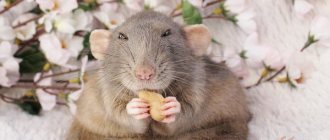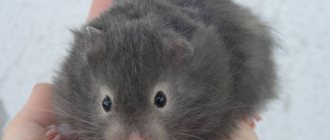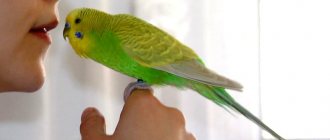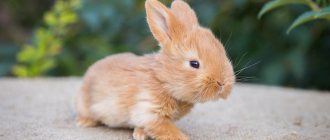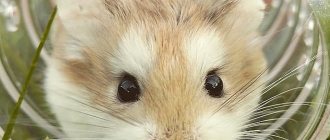Getting a pet without studying the physiological characteristics of the animal is a big mistake. Even our most common pets - cats, dogs, hamsters - have unique biological properties for their species, and therefore require unique care. Often the level of content does not take such nuances into account. The structure of a hamster is no simpler than that of any other mammal; it is the same gentle creature and sensitive to the world around it. Therefore, before taking responsibility for the comfort, health and life of the baby, please study the nature of the little furry. Today, as part of our article, we will talk about what structure a hamster has and what a hamster’s skeleton looks like.
Hamster oral cavity
The main uniqueness of Khomka is its legendary cheek pouches. These are very developed, capacious muscle cavities. They begin with a gap near the lips inside the mouth, the bottom of the natural pocket is in the neck near the shoulder joint. If they are stuffed to capacity (can hold 18g of food), the size of the head increases by 2 times.
The animal uses natural pockets in two ways:
- to eat the provisions stored there in the near future in a secluded place;
- or to transfer the spoils to an improvised barn, “for a rainy day.”
To unload the contents, the glutton has to forcefully squeeze out the contents with his paws. Bags also play a role in defense: to appear larger and scarier, their owner inflates his cheeks with air.
Diet
The animal can eat a variety of foods, but its main dish is plant food. Its diet includes grasses, peas, grains, flowers, corn, alfalfa, seeds and tubers. But on occasion, he will not refuse to snack on insects or invertebrates. Its victims can be frogs, lizards, chicks, and sometimes mice. As autumn approaches, hamsters begin to actively stock up on food, which they carry in their bags, holding them with their paws. By the beginning of winter, the animal’s pantries are filled with a large number of tubers and seeds (from 500 g to 25 kg). Therefore, in order to provide for itself, the common hamster prefers to settle near agricultural land. What is surprising is that this “owner” had storerooms found in his burrows, in which different varieties of cereals were stored separately.
Sometimes many relatives can be located in one territory, which leads to a lack of nutrition. Therefore, the common hamster can move to other areas. During such migrations, the animal is not even afraid of rivers, since it easily overcomes them.
Teeth
Those unfamiliar with the anatomy of the rodent are sure that it has only 4 teeth - 2 visible incisors on top and bottom. In fact, there are still small molars, 6 on each jaw. Designed for chopping food.
But the entire group of rodents lack fangs. There is a void between the incisors and chewing teeth - scientifically called a diastema.
Huge incisors are curved in the shape of an arc. The front part of the yellow color is not plaque, not caries, but the natural shade of an exceptionally hard layer of enamel, which is the cutting blade on the edge of the tooth. There are no roots, so the incisors are able to constantly grow. Regeneration of incisors in rodents is critical because the tip of the tooth is constantly worn away.
If your pet's diet contains a lot of soft food, grinding and sharpening of the incisors does not keep up with their growth, and then the latter reach unacceptable sizes. Subsequently, it will become difficult to close the mouth, gnaw, chew, which is fraught with the most tragic consequences. To save your pet, you need to go to a veterinary clinic, where they will perform an operation to shorten the incisors.
We described in more detail about the structure of a hamster’s teeth and how to shorten the incisors at home in this article.
To prevent critical cases, wooden sticks, solid food and toys should always be present near the hamster. For dessert, treat yourself to some kozinaki.
The upper part of the molars consists of tubercles, ridges, and folds. The thickness of the enamel here is not the same. When teeth wear down, sharp projections of harder enamel remain. Thanks to this property, a sharp, uneven relief is again obtained on the surface of the teeth.
Lifestyle
Many people also know from cartoons that a hamster is a thrifty animal. He is a good owner who works all summer. Around August, he begins to make global reserves to provide himself with food for the entire winter and spring. To preserve food, the common hamster digs long burrows of varying lengths. It has many passages and chambers, designed separately for a nest, several storerooms, a winter hut, a bedroom, and a dining room. In total, the length of all its corridors can be about 8 meters. All the chambers are located deep enough so that nothing happens to the animal’s treasures in the cold. Sometimes an ordinary hamster can take over a gopher's hole and settle there. In addition to collecting supplies, the animal keeps its bedding clean and regularly replaces it with fresh ones. With the onset of frost, the animal hibernates, waking up from time to time to refresh itself.
This animal is aggressive and does not tolerate the proximity of its relatives. If another hamster wanders into his territory, he will fight with him. It is known that, protecting the entrance to its burrow, this “fluffy” can attack not only predators, but even humans, and at the same time it is capable of painfully biting. But, despite such courage, the animal may die, becoming the prey of a ferret, fox or bird. He is able to run fast and jump sharply, but if he is calm, he walks quite slowly. Basically, the hamster begins to fuss and leave the hole only when evening comes. At dawn he goes to the shelter. An ordinary hamster spends his entire day there. The photo below shows the animal resting in a hole.
Animal skeletal system
It should be understood that the hamster's skeleton is extremely fragile. Khomka likes to climb tall objects, and quite often he can make a risky jump if he can’t get down or urgently needs shelter. His musculoskeletal complex cannot, like a cat’s, absorb shocks and shocks. Therefore, limb fractures often occur.
Features of Fluffy's Paws
The front legs are small but strong. In nature, rodents often dig hard ground with them. “How many fingers does a hamster have?” - a trick question. You can see 4 toes on these paws. There is a 5th, but it is not developed (rudiment). The hind limbs are weaker; with them it throws the dug soil behind itself. The skeleton of the Syrian and Djungarian hamsters has normally formed 5 fingers.
Ways to fight and protect
Nowadays, both modern methods of combating and protecting against these rodents, as well as proven old ones, are used. Here are the main ones:
- Flooding holes . You need to find all the exits, barricade them and pour water into the hole until the animal crawls out of the only hole. There you can catch him. Minus: be careful that you have found all the emergency exits from the hole, otherwise the hamster will hide.
- Digging holes and catching by hand . Disadvantage: very labor-intensive and dangerous.
- Domestic animals , cats and dogs, hunt rodents. Minus: hamsters are very large, not every cat can handle it. And a dog can trample the entire garden. In addition, the hamster can bite them and infect them.
- Various traps , live traps. Cons: It can be difficult to keep track of where it can get out and where to place them.
- Spreading poisoned baits . You can use rat and mouse poison. Minus: it is not a fact that the majority of individuals will eat it, especially since the number of pests is quickly restored.
- Use of noise and ultrasonic repellers . Disadvantage: it is difficult to place them over a large area and quite expensive.
The big problem is that hamsters are very active and cunning animals, and also fearless. Catching or scaring away a hamster in the countryside is not so easy.
Dear gardeners and gardeners! You must definitely try all the ways of fighting and destroying until you achieve success!
Otherwise, you risk not only being left without a harvest on your farm, but also your own health and life, as well as your loved ones!
rusfermer.net
The tail is an important detail
The tail of hamsters is relatively short. In some species it reaches a length of 12 mm. On average, the length is 7–10 mm. It happens that females, angry at males, gnaw their tails even more.
The main purpose of the organ is to protect the anus from infections. Constantly pay attention to its condition, because the disease, called after its main syndrome - “wet tail”, is notoriously popular. The diagnosis is diarrhea or diarrhea, the cause is sanitary conditions: poor quality food, dirty water or a carelessly cleaned cage. This is a serious disease - 90% of cases are fatal. Don't hesitate to make an appointment with your veterinarian as soon as you notice a wet tail.
Harm to a person - a farmer
It’s not hard to imagine the enormous harm wild hamsters cause to agriculture, farmers, gardeners and gardeners!
The huge number of pests and the ability to adapt to any conditions allow them to infest all rich territories, and the ability to build complex burrows makes them difficult to catch and destroy.
Everything that is grown in the garden is a delicacy for them, and hamsters will not give up so easily. Farmers face a serious struggle for their harvest!
In addition, wild hamsters can bite humans or domestic animals and livestock, which will most likely result in infection with various infections (up to 30 types), and possibly death.
The fleas that live on them and suck blood are no less dangerous. Rodents pose a serious threat, but the fight is all the more important!
Monitoring your hamster's normal body temperature
For this subfamily, the normal temperature is between 37.5 °C and 38.5 °C. Measurement is performed rectally: a thermometer is inserted into the anus. Measurement time - 5 minutes.
A hamster's body temperature is below normal - a sign of a developed infection. To provide first aid, fill a heating pad with warm water, wrap it in a cloth and place the patient in it for 10 minutes. After the procedure, wrap it in a heated cloth. In this form, it is advisable to take your pet to a veterinarian as soon as possible.
If the temperature is elevated, move the rodent to a cool place: near a windowsill or refrigerator. Also, do not delay visiting the doctor - some kind of infection is probably beginning to develop.
A miniature hamster is a special animal; it is better to study its physiology and structure of the hamster in more detail before purchasing. Agree, this short excursion into the biology of a rodent has taught you several new lessons on caring for the tiniest member of the family.
Did you like the article? Share with friends: [supsystic-social-sharing id=”1"]
- Related Posts
- Domestic rodents
- How to train a hamster
- How to determine the age of a hamster
« Previous entry
Distribution and reproduction
The wild hamster is a very unpretentious animal ; it is not afraid of arid steppes, mountains, forests, or proximity to humans. Distributed almost everywhere, from Europe to China.
The pest is not afraid of the harsh climate. He takes refuge safely in his hole. The main thing for rodents is to have something to eat, so they usually settle near fields and gardens.
They get close to dachas and villages to make supplies from the harvest in their gardens. Farmers are suffering from these pests everywhere, inventing new ways to combat them.
One male usually creates families with several females. The cubs are born blind and bald, but they grow very quickly and soon become involved in the process of replenishing the population.
A female wild hamster gives birth in the spring, and can sometimes give birth several times a year, under favorable conditions. They reproduce exponentially, with litters usually ranging from 6 to 18 cubs .
Other interesting anatomical features of funny rodents
Dentofacial apparatus
The number of teeth in a hamster is 16 (8 on the upper jaw and 8 on the lower, with the number of incisors being 2 each on the upper and lower jaws, and the number of molars being 6 each). Incisors do not have roots, due to which they have the ability to grow throughout the life of the animal. These teeth are covered with yellow enamel, which prevents excessive wear of the incisors.
Lateral glands for marking territory
Like many other animals, hamsters have special organs that secrete a special secretion. These organs in a hamster are the lateral glands, located on the back behind the ears and representing two inconspicuous black dots. The secret secreted by this organ allows the hamster in the wild to mark its territory and participate in the race for females.
Anatomical map of the internal organs of a hamster
The list of internal organs of this animal consists of:
- Pancreas.
- Spleens.
- Bladder.
- Appendages.
- Colon.
- Appendix.
- Semennikov.
- Liver.
- Gallbladder.
- Trachea.
- Stomach.
- Seminal vesicle.
- Small intestine.
- Hearts.
- Salivary gland.
- Esophagus.
- Lymph nodes.
- Glandular stomach.
- Parotid (lateral) glands.
- Pairs of lungs.
- Penis.
These are the animals - small, but very beautiful and unusual. We hope you found this information about the hamster's body structure useful and interesting.
What I am a master at is talking incessantly about hamsters. I have three hamsters at home, and my husband has a pet rat. That’s how we live, the six of us eat, the six of us sleep :)
Source
Characteristics
Most rodent lovers want to know everything about Siberian hamsters. The presence of features in behavior and characteristics is expressed by the following criteria:
- Siberian hamsters are called white Russian dwarf hamsters because of the special property of changing the color of their coat: from gray to white in winter;
- adults lead a calm and slow lifestyle in relation to the young;
- Siberian hamsters are mainly nocturnal. With the onset of darkness, which serves as protection for them from encounters with insidious predators - foxes and owls, they go out in search of food.;
- orientation in space with the help of whiskers allows animals to determine the width of loopholes and the distance between objects;
- rodents easily recognize each other by the smell of the marked territory;
- different-sex individuals of the breed live together only during the mating season, and the rest of the time they live separately and protect their homes from encroachment by other animals;
- with the onset of three months of age, females are able to reproduce with a gestation period of 19 days.
Source
Baby's paws
The animal has four legs. The front ones are small, but very strong. When living in the wild, they often dig the ground. There are 5 toes on the paws. Four of them are clearly visible, but the last one is almost invisible, since it is not sufficiently developed, although all 5 toes are visible in Djungarians.
As for the rear pair of limbs, they are less developed. In nature, the rodent throws away the dug soil with its hind legs so that it does not interfere with it.
What do they eat at home?
Hamsters will eat whatever you give them. But don’t feed them everything - the food we are used to can be deadly for these rodents.
Dry cereals are useful for a hamster: buckwheat, oats and rolled oats, barley, legumes, as well as nuts, sunflower and pumpkin seeds. Rice is given extremely rarely.
Provide the presence of fresh herbs, vegetables and fruits - wet food.
Important! Do not give your hamster fried, steamed, fatty, or salty foods. Human food is not suitable for the gastrointestinal tract of these animals.
Syrian hamster in exercise
What can you give from greens and vegetables?
Green food is an integral part of a hamster's diet.
A suitable option is fresh, young greens of sprouted dry food from the hamster’s main diet. It is advisable to give juicy grass only fresh, and in small pieces.
Hamsters can:
- Salad.
- Parsley.
- Dill.
- Dandelion leaves, plantain.
- Nettle.
- Clover.
- Hay.
Give greens that are clean and grown without the use of fertilizers or chemicals, preferably from a summer house or garden. This herb differs from store-bought herbs in that it contains no toxic contents.
Every other day, pamper your pet with juicy vegetable pieces:
Tomatoes But not all vegetables and fruits are beneficial for these animals. Due to ignorance of the specificity and nutritional properties of vegetation, hamster lovers have questions: can hamsters eat cabbage and pumpkin? Will red beets or hot radishes harm them?
Cabbage is definitely necessary in their diet. It is forbidden to give only the red-headed variety, as it may cause bloating and colic. Cauliflower and broccoli are ideal.
Cabbage in any form is contraindicated for small, immature hamsters!
Pumpkin and beets can be present in your pet’s feeder every day, but it is better to avoid radishes.
Important! Foods that cause bloating and gas formation can cause the death of a pet in 3-4 hours (for example, beans)!
What do you like from fruits and berries?
Hamsters love to eat sweet pieces of apples, bananas, and nibble on fresh currants. Sweet, juicy pieces are sure to delight furbabies.
Beginning hamster owners are faced with many questions regarding their care. In terms of nutrition, questions arise: can hamsters eat bananas, tangerines, pomegranates, grapes, persimmons and other overseas delicacies?
Give a banana no more than once a week, it can cause allergic reactions.
Limit your consumption of pear because it has a laxative effect.
Persimmon is allowed occasionally, and only soft, not very astringent.
Once every seven days, treat your hamster to apricots, peaches; in small quantities you can give raspberries, strawberries, and grapes.
Pomegranate, citrus fruits, pineapples, kiwis and watermelons are not recommended.
In winter, in the absence of such variety, give dried fruits.
Citrus
Allowed to give:
- Currant berries.
- Plums.
- Rose hip.
- Gooseberries.
- Rowan.
- Strawberries.
- Sea buckthorn.
- Cherry.
- Cherries.
- Blueberries.
- Dried apricots.
- Apples.
It is recommended to give berries without seeds!
It is preferable to choose apples of a sweet variety, and they can be introduced into complementary foods from 2 weeks of age.
What else to feed at home?
In addition to the above products, protein foods should be included in the hamsters' menu. In nature, they obtain this building product by eating small insects and worms. You can, of course, provide your hamster with live food, but in most cases this is problematic.
At home, it can be replaced with protein-containing products: chicken fillet, turkey or rabbit, boiled chicken or quail eggs, 2% cottage cheese or low-fat kefir.
Attention! Quail eggs are healthier for hamsters!
Can cheese, milk and dairy products be used as a source of protein? The answer is clear - no. The composition and fat content are not suitable for the gastrointestinal tract of hamsters and cause digestive disorders.
Attention! Opinions about cheese vary. Some sources claim the benefits of this dairy product, others, on the contrary, talk about its harm to the stomach of hamsters. In any case, you should not risk harming your pet, especially since such a possibility exists.
Chicken fillet is cooked without adding any spices or salt.
In specialized stores you can purchase natural sources of protein - butterflies, worms, grasshoppers.
In addition, pamper the animal with fish or shrimp, but in small quantities.
It is good for the teeth to give the animals dried wheat or rye bread. It not only grinds down teeth, but perfectly saturates the hamster and normalizes the functioning of the gastrointestinal tract. Under no circumstances should you give him crackers with added flavors or aromas; they are extremely harmful to his stomach.
Hamster
It is useful to give:
- Nuts: hazelnuts and walnuts.
- Seeds: flax, pumpkin, sunflower.
Vitamins
If your pet eats ready-made food from various cereals, then all the necessary vitamins and microelements are necessarily present there. Their presence must be indicated in the composition.
If your pet's diet is poor and you do not adhere to special rules, then it is better for you to buy special vitamin supplements. They are sold in regular pet stores. You should buy vitamins for hamsters; any others can significantly harm their health.
